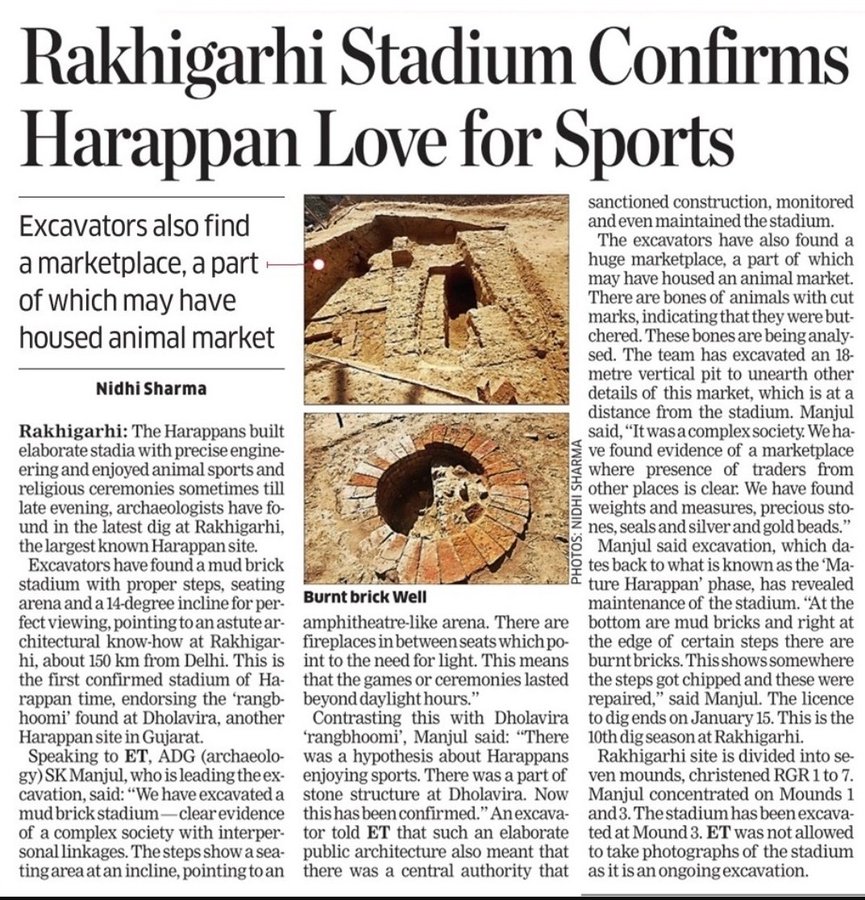A recent archaeological discovery of an ancient stadium at Rakhigarhi has left historians and enthusiasts awestruck. The precision of its design, the evidence of advanced engineering, and its cultural significance suggest that it wasn’t merely a place for sports but a center of social life in a long-forgotten civilization.

However, this discovery is just the beginning. The stadium opens a portal to an even more profound find – Rakhigarhi as a site rewrites the history of human civilization. Thus, the Sindhu Saraswati Civilization finds its proof in the arms of Rakhigarhi excavation. Thus, the site is more than an archaeological treasure; it’s a challenge to the Eurocentric timeline of history that has dominated academia for centuries.
Rakhigarhi: The Beating Heart of an Ancient Civilization
Indians made cheese over 4300 years ago by using perforated vessels placed inside a big pot like this from Rakhigarhi (2300 BCE) to filter out whey from boiled milk. A study analyzing lipid residues in unglazed ceramic vessels found evidence of dairy fats on perforated fragments. pic.twitter.com/4cXTykRwg1
— Savitri Mumukshu – सावित्री मुमुक्षु (@MumukshuSavitri) December 18, 2022
Rakhigarhi, nestled in Haryana, is the largest known site of the Sindhu Saraswati civilization. It dwarfs the famed Mohenjo-Daro in size and significance. Spanning an incredible 550 hectares, it paints a vivid picture of life over 8,000 years ago. Excavations have revealed a complex urban layout with planned streets, a sophisticated drainage system, and granaries that speak of organized governance and advanced agricultural practices.
The discoveries don’t stop there. Beads, pottery, and tools found in Rakhigarhi reveal a thriving artisan community.
Recently, a DNA analysis of some skeletal
remains at the Rakhigarhi site, have QUESTIONED
the so called "Aryan invasion theory"RAKHIGARHI SITE IN HARYANA
It is one of the five known biggest townships of
Harappan civilization on Indian sub-continent. pic.twitter.com/18gUjpBXaw— awakening bhārata 🇮🇳 (@TheRawFact) June 8, 2020
A burial site unearthed at the site shows evidence of intricate rituals, pointing to a society rich in culture and spiritual practices. But the most groundbreaking revelation came from DNA analysis. The DNA analysis linked the people of Rakhigarhi to modern Indian populations. This blows apart colonial-era myths of the “Aryan Invasion” and that Indian civilization was a result of external influences and migrations.
Primary results on ancient DNA sample from India (ie Rakhigarhi) indicates Dravidian expansion towards North Western India.😜😜
Remember this Guaneshwar Choubey who has coauthored papers with K Thangraj, Metspalu etc, he isn't some blog artist. pic.twitter.com/4mXj21Mw77
— हिरण्यरेता (@Hiranyareta) March 25, 2018
Thus, this site is not an isolated marvel but a crucial link in a network of over 2,000 sites that flourished along the Indus and Saraswati rivers. Together, they reveal a civilization that wasn’t just contemporary with Mesopotamia and Egypt but potentially older and more advanced in many respects.
The Saraswati Speaks: From Myth to Reality
Rakhigarhi is the largest Harappan site and is located on the Drishadvati River of Vedic fame along with the Sarasvati. https://t.co/EzUCam5jEd
— Dr David Frawley (@davidfrawleyved) January 12, 2025
For centuries, the Saraswati River was relegated to the realms of mythology by distorians! They dismissed the river as a figment of ancient Indian imagination and myths. Western scholars, relying on outdated colonial-era assumptions, denied its existence.
And the LeLi gang and their toolkit ensured that any voice that denied these assumptions on Saraswati was drowned out!
However, modern technology, particularly satellite imaging, has revealed the dried bed of a mighty river system matching the descriptions in the Rigveda and other ancient Indian texts. This discovery corroborates what Indian traditions have always maintained – the Saraswati River was real, and it supported a vibrant, advanced civilization.
All these major harappan sites are far away from Sindhu but dotted along the Saraswati river bed and we sill debate if it was even a real river. 😓
Kalibangan, Rakhigarhi, Banawali, Siswal etc.
Also notice archeological sites across the border in Pakistan. pic.twitter.com/Ng6kWLZFTa
— Ajey (@Paimaamu) July 12, 2022
Rakhigarhi stands as a testament to the Saraswati’s importance. The settlement’s location along this river system highlights how crucial it was to trade, agriculture, and cultural exchange. The Sindhu Saraswati civilization thrived at Rakhiagrhi and was deeply connected to nature, innovating sustainable systems that ensured prosperity for millennia.
Beyond the “4000 BCE” Narrative
A tiny bronze case (Pic 1) for storing kajal from Saraswati Sindhu site of Rakhigarhi (2600-1900 BCE).
The tradition of applying kajal continues in India even today. pic.twitter.com/TnfDNdOxeF— Indian Art (@IndiaArtHistory) September 21, 2021
Western academia has long adhered to a timeline that places the birth of advanced civilizations around 4000 BCE. This Eurocentric narrative allowed for the glorification of Mesopotamia and Egypt as the cradles of human progress. But Rakhigarhi and the Sindhu Saraswati sites shatter this glass ceiling.
Radiocarbon dating from these sites indicates continuous habitation stretching back at least 7,000 years, predating the so-called “first civilizations.”
As per latest #genetic studies on #Rakhigarhi skeleton, the people of the #IVC were the primary ancestors of most living Indians today.
The so called '#Aryan–#Dravidian' theory fails BIG.1/3 pic.twitter.com/mG6wk1fNh4
— GemsOfINDOLOGY (@GemsOfINDOLOGY) November 17, 2022
Why has the Western narrative resisted this reality? Acknowledging the Sindhu Saraswati civilization’s antiquity disrupts the colonial framework of dominance. The White Colonizers sought to minimize India’s contributions to global history. Additionally, this helped them deny the depth of the Indic Knowledge System. Thereafter, the blatant denial of Sanatani brilliance helped the Western academia attribute everything from algebra to physics to either Arabs or Greeks.
Rakhigarhi is evidence that from urban planning to metallurgy Sindhu Saraswati Civilization didn’t just compete with others but led them!
Why Rakhigarhi Matters Today?
One of the best Indus civilization experts in the country who headed the excavation of Rakhigarhi, Dr. Vasanta Shinde said that Harappan pottery was discovered from the site of Pandu Rajar Dhibi at Bardhaman.
This is a huge news. Till now it was dated back to 1500 BC. pic.twitter.com/kheVU9rC9S
— ককহ্ল ঋ্ঝ্বঁক্ষ্য (@From_Himalaya) April 14, 2022
Rakhigarhi is not just a historical marvel; it’s a bridge connecting modern India to its glorious past. Sanatanis are reawakening their identity as the torchbearers of philosophy, dharma, art, and science for millennia! Hence, the advanced society uncovered in Rakhigarhi cements the belief of 1.4 Billion Hindus in their civilizational truths!
Rakhigarhi’s excavation demonstrates a balance between urbanization, sustainability, and cultural depth.
Rakhigarhi in Haryana is now dated to be of 6000 BCE, or 8000 years old.
📍So India now holds not only the largest site from the Harappan culture, but also the oldest one (both Rakhigarhi).
Rakgarhi site is situated at the centre of the Ghaggar-Hakra basin (in the valley of… pic.twitter.com/cMfwh5pu3Q
— Monidipa Bose – Dey (মণিদীপা) (@monidipadey) December 26, 2023
These are lessons for modern societies grappling with environmental degradation and social inequality. This site also serves as a rebuttal to those who question the scientific and cultural achievements of ancient India. It validates the dating of texts like the Rigveda and the Mahabharata. Thus, showing to the world that these are not mere myths but reflections of a sophisticated civilization that valued knowledge, spirituality, and harmony.
The Sindhu Saraswati civilization demands a rewriting of history, one that honors its contributions without the filter of colonial biases.
Hence, the stadium and Rakhigarhi are more than archaeological sites. They are symbols of India’s indomitable spirit and its role as a global pioneer in ancient times. Therefore, the Western academia must now face the evidence. The sands of Rakhigarhi whisper truths that cannot be ignored. The Sindhu Saraswati civilization was not just an ancient society; it was a beacon of human progress. By accepting this, we move closer to a history that celebrates the achievements of all civilizations, not just those that fit neatly into a Eurocentric timeline.
It’s time for the world to acknowledge the reality of Rakhigarhi – a civilization older, wiser, and more advanced than previously imagined.
This is not just India’s story; it’s humanity’s story.


